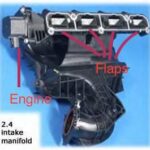Encountering a check engine light can be unsettling for any car owner. When the code reader displays code 174, it signals a specific issue that needs attention. As an experienced auto repair expert at keyfobprog.com, I’m here to break down what code 174 means, its common causes, and how to address it effectively.
Understanding the P0174 Code: System Too Lean (Bank 2)
The OBD-II diagnostic code P0174 indicates that your engine’s Bank 2 is running “too lean.” In simpler terms, the engine computer (PCM or ECM) has detected an imbalance in the air-fuel mixture, with too much air and not enough fuel in Bank 2. Engines are designed to operate with a precise air-fuel ratio for optimal combustion, fuel efficiency, and emission control. When the mixture leans out, it can lead to various performance problems and potentially damage engine components over time. It’s important to note that code P0174 often appears alongside P0171 (System Too Lean, Bank 1), suggesting a system-wide issue affecting both engine banks.
Common Causes of Code 174 and P0171
Several factors can contribute to a lean condition triggering code 174. Diagnosing the root cause is crucial for a lasting repair. Here are some of the most frequent culprits:
- Intake Manifold Gasket Leak: A leak in the intake manifold gasket is a very common cause, especially in older vehicles or those with certain engine designs like the Ford Windstar’s 3.8L engine mentioned in the original query. A faulty gasket allows unmetered air to enter the engine, leaning out the mixture.
- Vacuum Leaks: Similar to intake manifold leaks, vacuum leaks anywhere in the intake system can introduce extra air, disrupting the air-fuel ratio. Hoses, connections, and vacuum-operated components should be inspected.
- Mass Air Flow (MAF) Sensor Issues: The MAF sensor measures the amount of air entering the engine. If it’s dirty or malfunctioning, it might underreport airflow, causing the computer to reduce fuel delivery and create a lean condition.
- Fuel Delivery Problems: Insufficient fuel pressure or flow can also lead to a lean mixture. This could be due to a failing fuel pump, clogged fuel filter, or faulty fuel pressure regulator.
- Oxygen (O2) Sensor Malfunction: While less common as a direct cause of a lean condition, a faulty oxygen sensor can incorrectly report lean conditions to the PCM, even if the mixture is actually closer to normal. However, in most P0174 cases, the O2 sensors are correctly reporting a genuine lean condition.
Diagnosing and Repairing Code 174
Troubleshooting code 174 often involves a systematic approach:
- Visual Inspection: Start by checking for obvious vacuum leaks – listen for hissing sounds, inspect hoses for cracks or disconnections, and examine the intake manifold area for signs of gasket leaks.
- Scan Tool Data: Use an OBD-II scan tool to monitor live engine data, paying attention to fuel trims, MAF sensor readings, and oxygen sensor values. High positive fuel trim values often confirm a lean condition.
- Smoke Test: A smoke test can be highly effective in pinpointing vacuum leaks that are difficult to find visually.
- MAF Sensor Cleaning/Testing: Clean the MAF sensor with a MAF sensor cleaner. If cleaning doesn’t resolve the issue, testing or replacement might be necessary.
- Fuel Pressure Test: Check fuel pressure to rule out fuel delivery issues.
DIY vs. Professional Repair
For experienced DIY mechanics, addressing a potential intake manifold gasket leak, as suggested for the Ford Windstar, might be manageable. The linked resource in the original article provides a guide for this specific repair. However, diagnosing and repairing code 174 can become complex, especially if the cause isn’t immediately apparent. If you’re not comfortable with auto repair or lack the necessary tools and diagnostic equipment, it’s best to consult a professional mechanic. They have the expertise and tools to accurately diagnose and repair the issue efficiently.
Is Fixing Code 174 Worth It?
While the original article questions the value of fixing this issue on an older car, ignoring a P0174 code is generally not advisable. A lean running engine can lead to:
- Reduced Fuel Economy: Although counterintuitive, a lean condition can sometimes worsen fuel economy as the engine struggles to maintain optimal combustion.
- Engine Damage: Prolonged lean conditions can cause overheating, damage to catalytic converters, and even engine damage in severe cases due to increased combustion temperatures.
- Poor Performance: You may experience hesitation, rough idling, and a lack of power.
Addressing code 174 is essential for maintaining your vehicle’s performance, fuel efficiency, and longevity. Whether you choose to tackle it yourself or seek professional help, resolving the underlying issue will ensure your engine runs smoothly and reliably.
